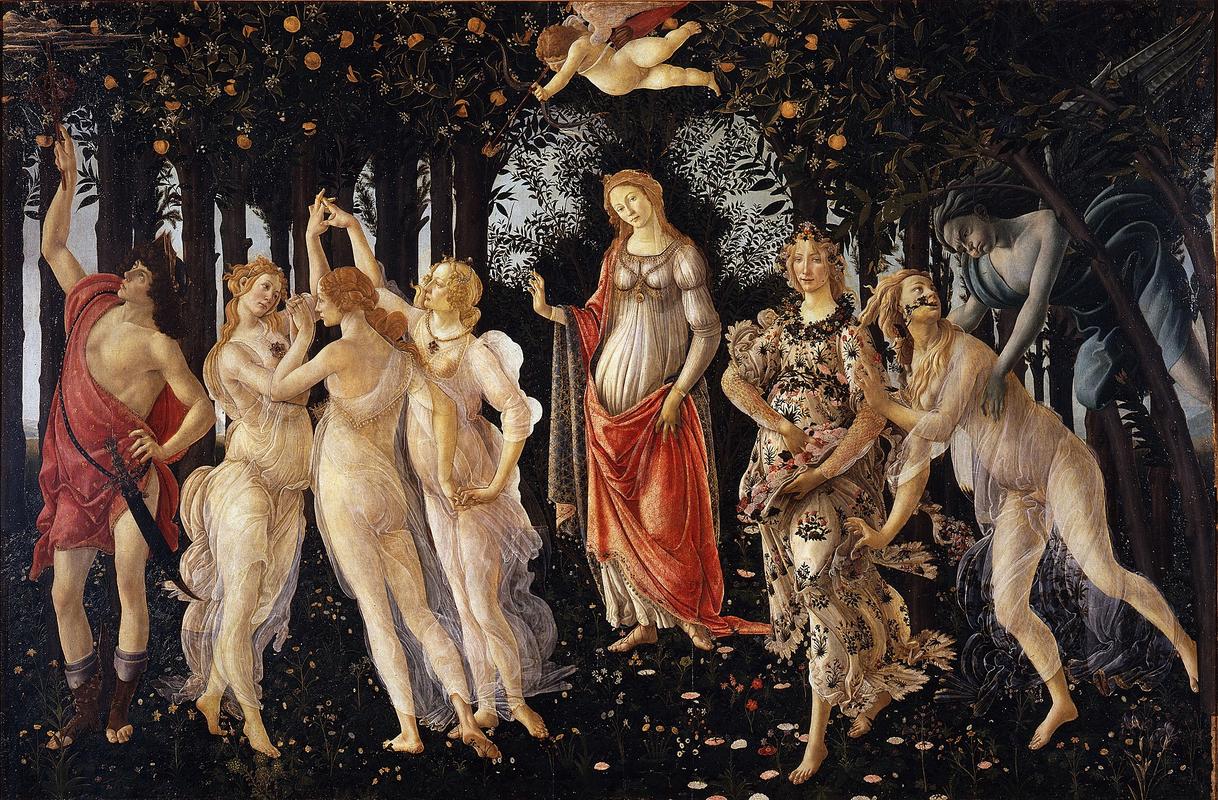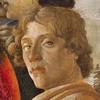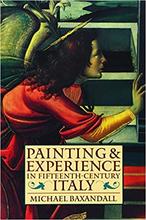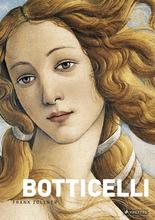More about Spring
- All
- Info
- Shop

Contributor
Simonetta Vespucci channels her inner Mariah Carey and asks, “Why you so obsessed with me?”
Simonetta Vespucci, aka the most attractive woman in Renaissance Europe and Sandro Botticelli’s frequent muse makes another appearance in Primavera, completed in 1482. Simonetta was renowned for her outstanding beauty and basically the “IT girl” of Florence; she was fawned over wherever she went and was the target of many hardcore crushes. Besides Botticelli, her most prominent admirer was golden boy Giuliano de’ Medici, who ruled Florence alongside his brother Lorenzo. While it was never confirmed, it was rumored that Giuliano and Simonetta had an affair, a belief that was only strengthened when they both suffered untimely deaths exactly 2 years apart to the day (unluckiest date in the world: April 26th). After Simonetta died at the age of 22 of what was probably tuberculosis, Giuliano was stabbed nineteen times by his family’s banking rivals, the Pazzi family.
Botticelli used Vespucci as his muse in many of his works, including arguably his two most famous, Birth of Venus and Primavera. Primavera, or Spring, is Botticelli’s way of showing the changing of the seasons. Read right to left, Spring literally arrives as the blue-faced Zephyr blows life into Flora, the pale, sickly woman, who looks downright terrified of him. Flora then transforms into the beautiful fauna-covered goddess Spring and scatters her flowers as far as she can reach. To the left, the three graces dance around in a circle to celebrate the seasonal change while the hunky Mercury pushes the winter clouds out of the sky like a meteorologist superhero. Venus, Goddess of Love stands at the center with her son Cupid hovering above her; included to remind everyone of the overwhelming power of love, delivering a heartwarming message to the hundreds of thousands of visitors to the Uffizi each year.
In this work alone, Simonetta is seen in every woman, or six out of the 8 ½ figures (one being tiny Cupid). By depicting her in so many of his works, Botticelli successfully created the ultimate female beauty ideal – high cheekbones, long limbs, sparkling eyes and thick flowing hair. It is a look we are still chasing after over 500 years later, making Botticelli pretty much the 14th century equivalent to a Maybelline ad.
This enormous work (almost 6 ½ x 10 feet!) hangs in one of the most famous rooms of the Uffizi, displayed alongside Birth of Venus, its companion piece. Both works were commissioned for the wedding of Lorenzo di Pierfrancesco de’ Medici, super rich banker cousin of Giuliano and Lorenzo, bringing everything back to the Medici family.
Featured Content
Here is what Wikipedia says about Primavera (Botticelli)
Primavera (
Italian pronunciation: [primaˈvɛːra], meaning "Spring") is a large panel painting in tempera paint by the Italian Renaissance painter Sandro Botticelli made in the late 1470s or early 1480s (datings vary). It has been described as "one of the most written about, and most controversial paintings in the world", and also "one of the most popular paintings in Western art".
The painting depicts a group of figures from classical mythology in a garden, but no story has been found that brings this particular group together. Most critics agree that the painting is an allegory based on the lush growth of Spring, but accounts of any precise meaning vary, though many involve the Renaissance Neoplatonism which then fascinated intellectual circles in Florence. The subject was first described as Primavera by the art historian Giorgio Vasari who saw it at Villa Castello, just outside Florence, by 1550.
Although the two are now known not to be a pair, the painting is inevitably discussed with Botticelli's other very large mythological painting, The Birth of Venus, also in the Uffizi. They are among the most famous paintings in the world, and icons of the Italian Renaissance; of the two, the Birth is even better known than the Primavera. As depictions of subjects from classical mythology on a very large scale, they were virtually unprecedented in Western art since classical antiquity.
The history of the painting is not certainly known; it may have been commissioned by one of the Medici family, but the certainty of its commission is unknown. It draws from a number of classical and Renaissance literary sources, including the works of the Ancient Roman poet Ovid and, less certainly, Lucretius, and may also allude to a poem by Poliziano, the Medici house poet who may have helped Botticelli devise the composition. Since 1919 the painting has been part of the collection of the Uffizi Gallery in Florence, Italy.
Check out the full Wikipedia article about Primavera (Botticelli)

















